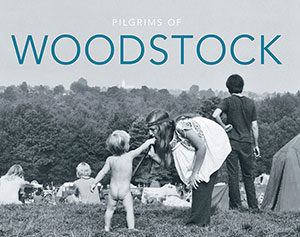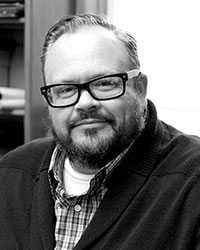
A multimedia presentation about the book “Pilgrims of Woodstock” will take place at Somerville Public Library on Saturday, November 9.
By Blake Maddux
“My heart is in Somerville,” says New Hampshire resident John Kane, a college professor and recent first-time author.
“I have a tile in the Davis Square T stop on the Holland Street side,” Kane explains. “I went through the Somerville school system. I was kind of an apartment rat. I moved around a lot as a kid.”
Professor Kane’s interest in music festivals has led to his becoming a scholar on the subject. He humbly brags, “For a Gen Xer, I know more than I need to know about 1960s youth culture, in particular about those who attended Woodstock,” which happened the year before he was born.
Not only does he know about the attendees, he knows many personally: “The Ercolines, the couple on the cover of the Woodstock album, they’re friends of mine.”

John Kane, author of “Pilgrims of Woodstock.”
Kane’s forthcoming book, The Last Seat in the House: The Story of Hanley Sound, is slated for publication this coming February. In the course of his research about Bill Hanley, the Medford, MA native who was the sound engineer at Woodstock, Kane learned of the availability of photos taken by the late Richard F. Bellak. Intrigued, he purchased the collection, unaware that it would lead to Pilgrims of Woodstock, which was released in August.
Pilgrims of Woodstock includes Bellak’s never-before-seen photos and Kane’s interviews with 30 people who arrived at Max Yasgur’s farm in Bethel, NY, at various points of time between August 15 and 17, 1969.
“To hear how Woodstock affected the lives of the people was of real interest to me,” Kane says of the interviews. “How did Woodstock, if at all, change you?”
Kane will present a comprehensive multimedia presentation about the book, followed by a Q&A session, at Somerville Public Library on Saturday, November 9 at 1:00 p.m.
The Somerville Times: Did you spend a lot of time at Somerville Library throughout your youth?
John Kane: Oh yeah. After school and on the weekends, that’s where kids would go and read books. On class trips we’d go to the library. For me to just be able to be there [as a presenter], having been a kid growing up within a stone’s throw from the Somerville Library, it’s a real honor.
TST: How did you acquire the “never-before-seen photos” of Woodstock?
JK: Someone had turned me on to the Bellak collection. Sadly, Bellak took his life in 2015 and he had no heirs. After two years, it went up for bid. When the negatives were offered with the collection and the sole exclusive rights of ownership and licensing and the whole shabang, I thought, this is probably a good thing to do. At that point, the idea of Pilgrims of Woodstock wasn’t born.
TST: So how was the idea of Pilgrims of Woodstock born?
JK: The University Press of Mississippi jumped on the opportunity to publish The Last Seat in the House, but before that I received a whole flurry of rejection letters from various publishers. Indiana University Press said they liked what I wrote about Hanley, but asked if I would I consider writing a book about Woodstock for the fiftieth [anniversary]. I said of course!
I thought, well, I have this beautiful collection of photographs that I own and that solely focus on the audience experience. Uniquely, Bellak only focuses his lens on the audience, not the stage. I also have access to many people that went to Woodstock or could put me in touch with those who did. So the idea came about when I decided I wanted a book that would be different in appearance and also in content. So I interviewed 40 people and cherry-picked 30 of the most diverse voices. For example, what was it like to be in the audience as a Vietnam veteran? What was it like to be a black man in the Woodstock audience? What was it like to be a gay female from another country? What was it like to be Hispanic? A journalist? A conservative? A liberal? This is what makes Pilgrims of Woodstock a different kind of book.
TST: In addition to their focus on the audience, in what ways do Bellak’s photos contribute to that uniqueness?
JK: There’s no tie-dye imagery. There’s no typical decorative peace signs. So many Woodstock books are clichéd in this way. A regurgitation of the same old imagery and textures did not interest me. I wanted Pilgrims to be much different than that.
TST: Have any Woodstock attendees come to your talks?
JK: At a talk in Hancock, NH, which has one main street with a general store and a library and a bank, 60 people showed up and 17 of them were Woodstock attendees! At almost every talk, I get somebody that was at Woodstock. When they’re there, it makes the experience better because they’re the rock stars in the room. One guy who was at Woodstock came to two or three of the talks. At my first talk, in Rochester, VT, I had about seven Woodstock attendees. That was probably the second largest grouping of Woodstock attendees at my presentations.
I’ve had many people thank me and tell me that I brought them back and made them feel like they were there again. I’ve tried my best to create an immersive experience with this presentation, and I believe I have been successful.
TST: Do you wish that you could have been at Woodstock?
JK: I say this all the time: I would never have wanted to go to Woodstock. The conditions were just entirely uncomfortable and the Vietnam War was looming overhead. You can see it on people’s faces in the photos. In my view, the 1960s are very over popularized and glamorized. If I were to have had a chance to go to Woodstock, it would have been on the production side. On staff, backstage. But not in the audience. Definitely not.















Reader Comments